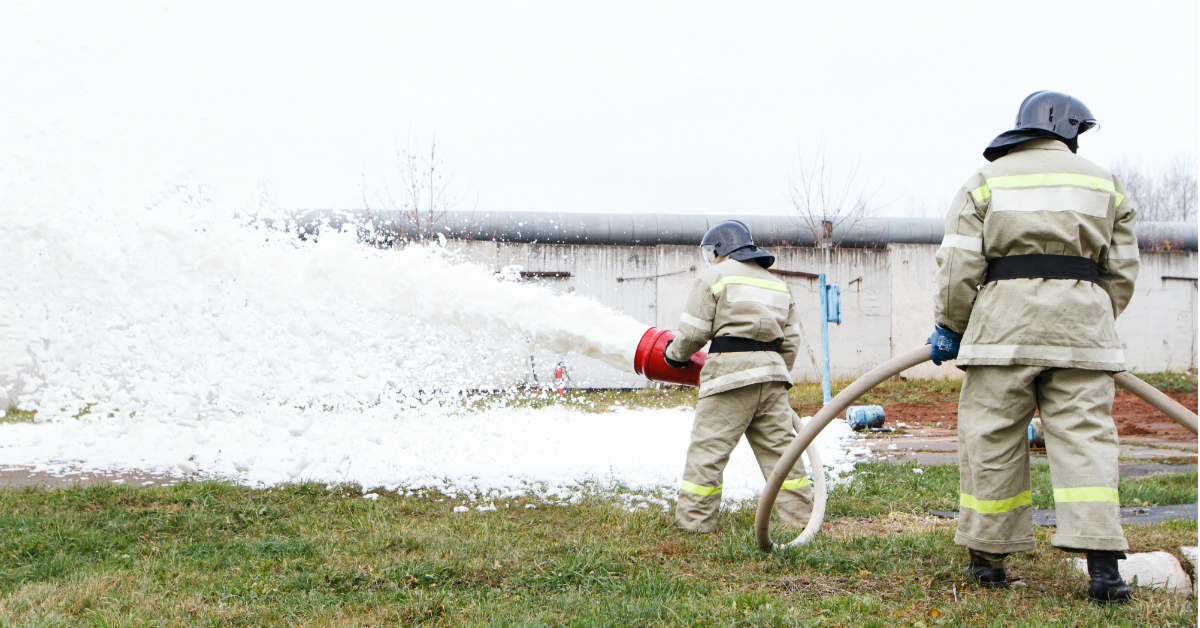- Read our letter to the FAA
- View our Congressional briefing
- Read the Congressional sign-on letter to the FAA
Here’s how a federal agency “meets” a deadline without actually doing what Congress wanted it to do by that deadline.
For many years, civilian airports have been forced by Federal Aviation Administration (FAA) rules to stock and use PFAS-based firefighting foam. Responding to rapidly growing public concern about toxic firefighting foams harming firefighters and polluting drinking water near airports across the county, Congress took action in 2018. Sec 332 of the FAA Reauthorization Act of 2018 (PL: 115-254) gave the FAA three years to adjust its requirements for airports to allow the use of firefighting foams that do not contain dangerous PFAS. Monday, October 4, 2021, was the FAA’s due date to allow civilian airports to use firefighting foams without toxic PFAS chemicals.
The FAA has not done enough in the past three years to help airports move to safer foams that are already in use around the world. At the eleventh hour, FAA issued a classic DC doublespeak “CertAlert” to airports announcing that the firefighting foam standard that applies to airports no longer requires the use of fluorinated chemicals (i.e. PFAS). However, it failed to change the requirement for airports to meet the military standard, which is based on how fluorinated foams perform. The FAA says airports can seek approval for PFAS-free foams—but lays out no clear path for them to achieve this approval.
In essence, PFAS firefighting foams are still required at America’s airports because they are the only foams that can meet the military performance specification required by FAA.
This was not the intent of Congress when it directed the FAA to actually allow the use of PFAS-free foams by October 4, 2021.
PFAS firefighting foams are dangerous
Per- and polyfluoroalkyl substances (PFAS) are extremely persistent chemicals linked to cancer, liver toxicity, and other health effects. Firefighters have used and trained with PFAS-based foam at commercial and military airports for decades. The PFAS in foam has contaminated drinking water for millions of people nationwide while also putting firefighters at greater risk of toxic chemical exposures that can cause cancer and chronic disease.
Companies like 3M and DuPont knew for years that PFAS were harmful, but they continued to make the chemicals and put them into a wide array of products. 3M, which recently settled a lawsuit with the state of Minnesota for $850 million, phased out its production of PFAS for firefighting foam by the end of 2002, but other companies have continued to make it.
Congress told the FAA to stop requiring PFAS foams
Recognizing the persistent threat of PFAS-based firefighting foams to community water supplies, the vulnerability of first responders, the potential liability of the airports, and the growing availability of PFAS-free alternatives, Congress told the FAA to allow commercial airports to use PFAS-free firefighting foams in its 2018 Federal Aviation Administration reauthorization bill.
When we talked to Hill offices about the 2018 FAA bill, staff and elected officials were hearing more and more from communities and water utilities that were alarmed by contamination of their drinking water and the high price tag they were seeing for filtration and cleanups.
Firefighting foams without PFAS are already used successfully around the world, but outdated federal guidelines have kept foams containing PFAS in use for training and firefighting at U.S. commercial and military airports.
The good news and the bad news
Congress has already directed the military to phase out its use of such foams by 2024. Plus, states have taken action and the market for safer alternatives is growing, including for airports.
The good news is that:
- Nine states including Washington, Illinois, New York, and California, have enacted laws that prohibit the sale or use of PFAS foams.
- A new certification that evaluates PFAS and other hazardous substances in firefighting foam has launched with a dozen foams already certified, including an aviation foam.
- Airports around the world are successfully using PFAS-free foams, including London Heathrow, Gatwick, Stansted and City, Manchester, Paris Charles De Gaulle, Paris Orly, Lyon, Helsinki, Lisbon, Dubai, Brussels, Copenhagen, Oslo, Stockholm, Stuttgart, Dortmund, Sydney, Melbourne and Brisbane.
- The airport demand for PFAS-free foams and the market continues to grow.
The bad news is that FAA’s failure to meet the deadlines is contributing to ongoing contamination and exposures:
- The June 2019 spill of PFAS foam at Connecticut’s Bradley International Airport contaminated the local river and fish.
- In April 2019, an accidental spill of PFAS foam from the airport contaminated a stream in the city of Newburgh, NY. The city had already lost its primary drinking water source due to use of PFAS foam at Stewart Air National Guard base and Stewart International Airport.
- In March 2019, California state water boards requested plans for PFAS testing at 27 airports and initial results found that levels of PFAS in groundwater and surface water “far exceeded” the concentrations detected in water near landfills and public supply wells. FAA’s requirement for PFAS foams affects 524 airports across the country, which can all be considered suspect for PFAS contamination.
The FAA must take responsibility for ending drinking water contamination
States are taking action to end the use of these dangerous chemicals, but they need the partnership of federal agencies like the FAA. It is past time for the FAA to step up to the plate and do the job Congress told it to do.
Instead of continued delay and further contamination, the FAA should act now to follow the direction given by Congress and allow civilian airports to use fluorine-free foam, using an international standard that is in use at airports around the world.





